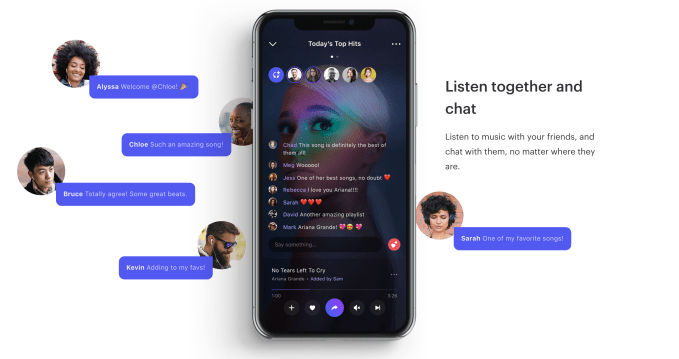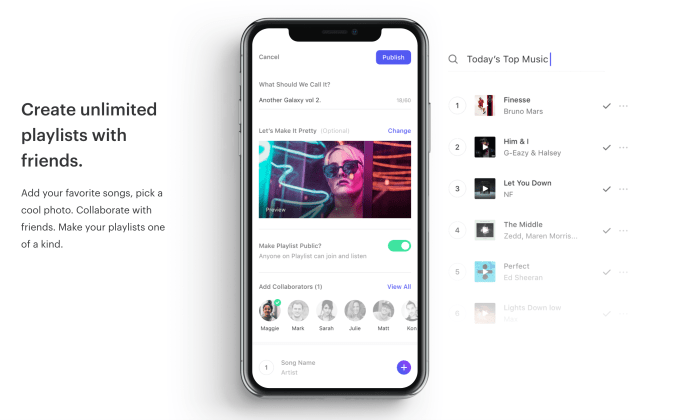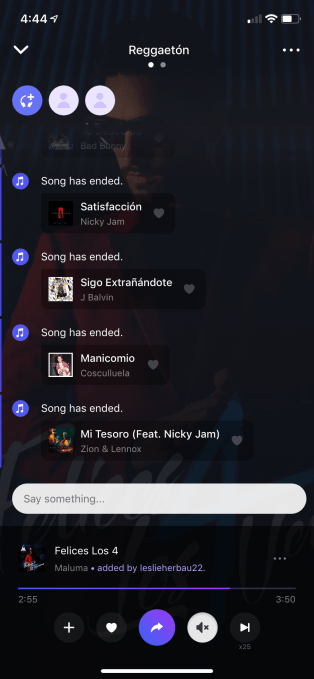
Social music app Playlist lets you listen to music with others in real time
A new app called Playlist aims to manufacture music a more social event than what’s offered today by the major music scaffolds like Apple Music, Pandora or Spotify, for example. In Playlist, you can find the ones who share your musical flavours and join group converses where you listen to playlists together in real period. You can collaborate on playlists, too.
The app, backed by asset from Stanford’s StartX fund, was founded by Karen Katz and Steve Petersen, both Stanford architects and serial inventors. Katz previously co-founded AdSpace Networks and another social music pulpit, Jam Music. She also was a founding ministerial unit representative at Photobucket, and founded a company announced Project Playlist, which was like a Google search for music back in the Myspace era.
Peterson, meanwhile, has 35 patents and more than a decade of suffer in digital music. In the early 2000 s he formed the software architecture and ran the team at PortalPlayer Inc ., which powered the iPod’s music actor and was afterward sold to Nvidia for $357 million. Subsequentlies, he was CTO at Concert Technology, a engineering incubator and intellectual property rights firm with particular attention paid to portable, social and digital music services.
” The life has departed social, but music has been generally left behind. That’s a real breach ,” explains Katz, to the reasons why the founders wanted to build Playlist in the first place.
” Ever since we started listening to music from our mobile phones, it’s become an segregated knowledge. And music is the number one thing we do on our telephones ,” she says.
The idea they came up with was to unite music and messaging by synchronizing series, so parties could listen to anthems together at the same hour and converses while they do so.

During last year’s beta testing age, Playlist( which was listed under a different mention on the App Store ), realized a huge number of bookings as a result of its real-time nature.
” Out of the gate, we learnt 10 meters the participation of Pandora. Beings have, on average, 60 interactions per hour — like converses, likes, follows, participates, adds and originates ,” Katz says.
Under the hood, the app exerts a good deal of technology beyond just its synchronized stream. It also leverages machine learning for its social recommendations, as well as collaborative playlists, large-scale group schmooze, and behavior-based music program, and has ” Music Match” algorithms to help you find people who listen to the same sort of things you do.
The social aspects of the app commits a following/ follower pattern, and presents playlists from the person or persons you follow in your residence feed, much like a music-focused account of Instagram. A separate Discover section gives you find more people to follow or join in other favourite listening and chat sessions.

At launch, the app has a list of more than 45 million chorus and has a music license for the U.S. It plans to monetize through advertising.
The core idea now — real-time music listening and chat — is interesting. It’s like a Turntable.fm for the Instagram age. But the app sometimes overcomplicates occasions, it seems. For sample, importing a playlist from another music app involves switch back to that app, receiving the playlist and facsimile its sharing URL, then switching back to Playlist to glue it in a pop-up box. It then offers a lane for you to add your own custom photo to the playlist, which feels a bit wasteful as the default is album art.
Another odd option is that it’s difficult to figure out how to leave a group chat once you’ve affiliated. You can subdue the playlist that’s streaming or you can downplay the player, but the option to “leave” is tucked away under another menu, obligating it harder to find.
The player interface also offers a feeling, a plus (+), a share button, a mute button and a skip button all on the bottom sequence. It’s … well … it’s a lot.

But Katz says that the design picks they’ve attained here are based on thorough consumer testing and feedback. Plus, the app’s younger consumers — often high schoolers, and not much older than 21 — are the ones challenging all the buttons and options.
It’s hard to argue with the results. The beta app bought more than 500,000 users during last year’s test period, and those users are being switched over to the now publicly available Playlist app, which has some 80 K lays as of last week, according to Sensor Tower data.
The company likewise plans to leverage the assets it acquired from the old-fashioned Project Playlist, which includes some 30 million emails, 21 million Facebook IDs and 14 million Twitter IDs. A” Throwback Thursday” market expedition will reach out to those useds to offer them a nature to listen to their age-old playlists.
The startup has raised$ 5 million in funding( convertible observes) from Stanford StartX Fund, Garage Technology Ventures, Miramar Ventures, IT-Farm, Dixon Doll( DCM founder ), Stanford Farmers& Angels, Zapis Capital and Amino Capital.
The Palo Alto-based corporation is a squad of six full-time.
Playlist is a free download for iOS. An Android form is in the works.
Read more: feedproxy.google.com

